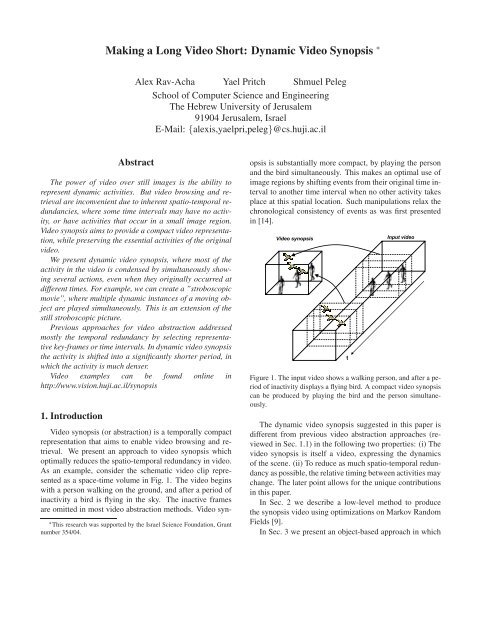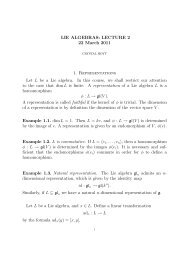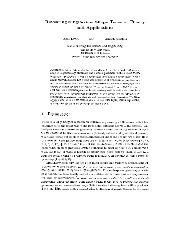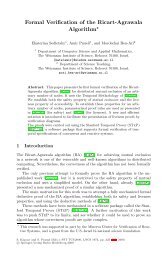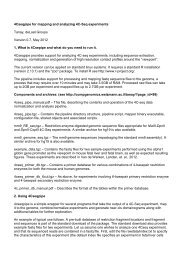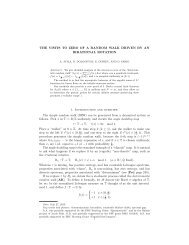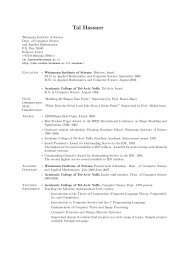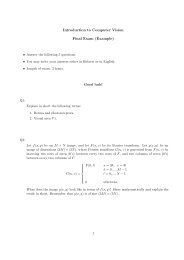Making a Long Video Short: Dynamic Video Synopsis
Making a Long Video Short: Dynamic Video Synopsis
Making a Long Video Short: Dynamic Video Synopsis
You also want an ePaper? Increase the reach of your titles
YUMPU automatically turns print PDFs into web optimized ePapers that Google loves.
<strong>Making</strong> a <strong>Long</strong> <strong>Video</strong> <strong>Short</strong>: <strong>Dynamic</strong> <strong>Video</strong> <strong>Synopsis</strong> ∗<br />
Alex Rav-Acha Yael Pritch Shmuel Peleg<br />
School of Computer Science and Engineering<br />
The Hebrew University of Jerusalem<br />
91904 Jerusalem, Israel<br />
E-Mail: {alexis,yaelpri,peleg}@cs.huji.ac.il<br />
Abstract<br />
The power of video over still images is the ability to<br />
represent dynamic activities. But video browsing and retrieval<br />
are inconvenient due to inherent spatio-temporal redundancies,<br />
where some time intervals may have no activity,<br />
or have activities that occur in a small image region.<br />
<strong>Video</strong> synopsis aims to provide a compact video representation,<br />
while preserving the essential activities of the original<br />
video.<br />
We present dynamic video synopsis, where most of the<br />
activity in the video is condensed by simultaneously showing<br />
several actions, even when they originally occurred at<br />
different times. For example, we can create a ”stroboscopic<br />
movie”, where multiple dynamic instances of a moving object<br />
are played simultaneously. This is an extension of the<br />
still stroboscopic picture.<br />
Previous approaches for video abstraction addressed<br />
mostly the temporal redundancy by selecting representative<br />
key-frames or time intervals. In dynamic video synopsis<br />
the activity is shifted into a significantly shorter period, in<br />
which the activity is much denser.<br />
<strong>Video</strong> examples can be found online in<br />
http://www.vision.huji.ac.il/synopsis<br />
1. Introduction<br />
<strong>Video</strong> synopsis (or abstraction) is a temporally compact<br />
representation that aims to enable video browsing and retrieval.<br />
We present an approach to video synopsis which<br />
optimally reduces the spatio-temporal redundancy in video.<br />
As an example, consider the schematic video clip represented<br />
as a space-time volume in Fig. 1. The video begins<br />
with a person walking on the ground, and after a period of<br />
inactivity a bird is flying in the sky. The inactive frames<br />
are omitted in most video abstraction methods. <strong>Video</strong> syn-<br />
∗ This research was supported by the Israel Science Foundation, Grant<br />
number 354/04.<br />
opsis is substantially more compact, by playing the person<br />
and the bird simultaneously. This makes an optimal use of<br />
image regions by shifting events from their original time interval<br />
to another time interval when no other activity takes<br />
place at this spatial location. Such manipulations relax the<br />
chronological consistency of events as was first presented<br />
in [14].<br />
<strong>Video</strong> synopsis<br />
t<br />
Input video<br />
Figure 1. The input video shows a walking person, and after a period<br />
of inactivity displays a flying bird. A compact video synopsis<br />
can be produced by playing the bird and the person simultaneously.<br />
The dynamic video synopsis suggested in this paper is<br />
different from previous video abstraction approaches (reviewed<br />
in Sec. 1.1) in the following two properties: (i) The<br />
video synopsis is itself a video, expressing the dynamics<br />
of the scene. (ii) To reduce as much spatio-temporal redundancy<br />
as possible, the relative timing between activities may<br />
change. The later point allows for the unique contributions<br />
in this paper.<br />
In Sec. 2 we describe a low-level method to produce<br />
the synopsis video using optimizations on Markov Random<br />
Fields [9].<br />
In Sec. 3 we present an object-based approach in which
objects are extracted from the input video. Similar moving<br />
object detection was also done in other object-based video<br />
summary methods [7, 5, 16]. However, these methods use<br />
object detection for identifying significant key frames and<br />
do not combine activities from different time intervals. The<br />
detection of moving objects, as was used in our experiments<br />
is described in Sect. 1.2.<br />
One of the options presented in this work is the ability<br />
to display multiple dynamic appearances of a single object.<br />
This effect is a generalization of the “stroboscopic” pictures<br />
used in traditional video synopsis of moving objects [6, 1].<br />
Since this work presents a video-to-video transformation,<br />
the reader is encouraged to view the video examples<br />
in http://www.vision.huji.ac.il/synopsis.<br />
1.1. Related Work on <strong>Video</strong> Abstraction<br />
There are two main approaches for video synopsis (or<br />
video abstraction). In one approach, a set of salient images<br />
(key frames) is selected from the original video sequence.<br />
The key frames that are selected are the ones that best represent<br />
the video [7, 18]. In another approach a collection of<br />
short video sequences is selected [15]. The second approach<br />
is less compact, but gives a better impression of the scene<br />
dynamics. Those approaches (and others) are described in<br />
comprehensive surveys on video abstraction [10, 11].<br />
In both approaches above, entire frames are used as the<br />
fundamental building blocks. A different methodology uses<br />
mosaic images together with some meta-data for video indexing<br />
[6, 13, 12]. In this case the static synopsis image<br />
includes objects from different times.<br />
1.2. Activity Detection<br />
This work assumes that every input pixel has been labeled<br />
with its level of “activity”. Evaluation of the activity<br />
level is out of the scope of our work, and can be done using<br />
one of various methods for detecting irregularities [4, 17],<br />
moving object detection, and object tracking.<br />
We have selected for our experiments a simple and<br />
commonly used activity indicator, where an input pixel<br />
I(x, y, t) is labeled as “active” if its color difference from<br />
the temporal median at location (x, y) is larger than a given<br />
threshold.<br />
Active pixels are defined by the characteristic function<br />
{ 1 ifpisactive<br />
χ(p) =<br />
0 otherwise,<br />
To clean the activity indicator from noise, a median filter is<br />
applied to χ before continuing with the synopsis process.<br />
While it is possible to use a continuous activity measure,<br />
we have concentrated in this paper on the binary case.<br />
A continuous activity measure can be used with almost all<br />
equations in this paper with only minor changes.<br />
2. <strong>Video</strong> <strong>Synopsis</strong> by Energy Minimization<br />
Let N frames of an input video sequence be represented<br />
in a 3D space-time volume I(x, y, t), where (x, y) are the<br />
spatial coordinates of this pixel, and 1 ≤ t ≤ N is the frame<br />
number.<br />
We would like to generate a synopsis video S(x, y, t)<br />
having the following properties:<br />
• The video synopsis S should be substantially shorter<br />
than the original video I.<br />
• Maximum “activity” from the original video should<br />
appear in the synopsis video.<br />
• The motion of objects in the video synopsis should be<br />
similar to their motion in the original video.<br />
• The video synopsis should look good, and visible<br />
seams or fragmented objects should be avoided.<br />
The synopsis video S having the above properties is generated<br />
with a mapping M, assigning to every coordinate<br />
(x, y, t) in the synopsis S the coordinates of a source pixel<br />
from I. We focus in this paper on time shift of pixels, keeping<br />
the spatial locations fixed. Thus, any synopsis pixel<br />
S(x, y, t) can come from an input pixel I(x, y, M(x, y, t)).<br />
The time shift M is obtained by solving an energy minimization<br />
problem, where the cost function is given by<br />
E(M) =E a (M)+αE d (M), (1)<br />
where E a (M) indicates the loss in activity, and E d (M)<br />
indicates the discontinuity across seams. The loss of activity<br />
will be the number of active pixels in the input video I<br />
that do not appear in the synopsis video S,<br />
E a (M) =<br />
∑<br />
(x,y,t)∈I<br />
χ(x, y, t)−<br />
∑<br />
(x,y,t)∈S<br />
χ(x, y, M(x, y, t)).<br />
(2)<br />
The discontinuity cost E d is defined as the sum of color<br />
differences across seams between spatiotemporal neighbors<br />
in the synopsis video and the corresponding neighbors in<br />
the input video (A similar formulation can be found in [1]):<br />
E d (M) =<br />
∑<br />
(x,y,t)∈S<br />
∑<br />
‖ S((x, y, t)+e i ) − (3)<br />
i<br />
I((x, y, M(x, y, t)) + e i ) ‖ 2<br />
where e i are the six unit vectors representing the six<br />
spatio-temporal neighbors. A demonstration of the spacetime<br />
operations that create a short video synopsis by minimizing<br />
the cost function (1) is shown in Fig. 2.a.
Input<br />
video<br />
B<br />
<strong>Video</strong><br />
synopsis<br />
t<br />
A<br />
(a)<br />
(b)<br />
Figure 3. The activity in a surveillance video can be condensed<br />
into a much shorter video synopsis. (a) A typical frame from the<br />
original video. (b) A frame from the video synopsis.<br />
x<br />
(a)<br />
(b)<br />
Figure 2. In this space-time representation of video, moving objects<br />
created the “activity strips”. The upper part represents the<br />
original video, while the lower part represents the video synopsis.<br />
(a) The shorter video synopsis S is generated from the input video<br />
I by including most active pixels. To assure smoothness, when<br />
pixel A in S corresponds to pixel B in I, their “cross border”<br />
neighbors should be similar.<br />
(b) Consecutive pixels in the synopsis video are restricted to come<br />
from consecutive input pixels.<br />
Notice that the cost function E(M) (Eq. 1) corresponds<br />
to a 3D Markov random field (MRF) where each node corresponds<br />
to a pixel in the 3D volume of the output movie,<br />
and can be assigned any time value corresponding to an input<br />
frame. The weights on the nodes are determined by the<br />
activity cost, while the edges between nodes are determined<br />
according to the discontinuity cost. The cost function can<br />
therefore be minimized by algorithms like iterative graphcuts<br />
[9].<br />
2.1. Restricted Solution Using a 2D Graph<br />
The optimization of Eq. (1), allowing each pixel in the<br />
video synopsis to come from any time, is a large-scale problem.<br />
For example, an input video of 3 minutes which is<br />
summarized into a video synopsis of 5 seconds results in<br />
a graph with approximately 2 25 nodes, each having 5400<br />
labels.<br />
It was shown in [2] that for cases of dynamic textures<br />
or objects that move in horizontal path, 3D MRFs can be<br />
solved efficiently by reducing the problem into a 1D problem.<br />
In this work we address objects that move in a more<br />
general way, and therefore we use different constraints.<br />
Consecutive pixels in the synopsis video S are restricted<br />
to come from consecutive pixels in the input video I. Under<br />
this restriction the 3D graph is reduced to a 2D graph<br />
where each node corresponds to a spatial location in the<br />
synopsis movie. The label of each node M(x, y) determines<br />
the frame number t in I shown in the first frame<br />
of S, as illustrated in Fig. 2.b. A seam exists between<br />
two neighboring locations (x 1 ,y 1 ) and (x 2 ,y 2 ) in S if<br />
M(x 1 ,y 1 ) ≠ M(x 2 ,y 2 ), and the discontinuity cost E d (M)<br />
along the seam is a sum of the color differences at this spatial<br />
location over all frames in S.<br />
E d (M) = ∑ ∑ K∑<br />
|| S((x, y, t)+e i ) − (4)<br />
x,y i t=1<br />
I((x, y, M(x, y)+t)+e i ) || 2<br />
where e i are now four unit vectors describing the four<br />
spatial neighbors.<br />
The number of labels for each node is N − K, where<br />
N and K are the number of frames in the input and output<br />
videos respectively. The activity loss for each pixel is:<br />
E a (M) = ∑ N∑<br />
K∑<br />
( χ(x, y, t) − χ(x, y, M(x, y)+t)).<br />
x,y<br />
t=1<br />
t=1<br />
Fig. 3 shows an original frame, and a frame from a synopsis<br />
video that was obtained using this restricted solver.<br />
3. Object-Based <strong>Synopsis</strong><br />
The low-level approach for dynamic video synopsis as<br />
described earlier is limited to satisfying local properties<br />
such as avoiding visible seams. Higher level object-based<br />
properties can be incorporated when objects can be detected.<br />
For example, avoiding the stroboscopic effect requires<br />
the detection and tracking of each object in the volume.<br />
This section describes an implementation of objectbased<br />
approach for dynamic video synopsis. Several objectbased<br />
video summary methods exist in the literature (for example<br />
[7, 5, 16]), and they all use the detected objects for<br />
the selection of significant frames. Unlike these methods,<br />
we shift objects in time and create new synopsis frames that<br />
never appeared in the input sequence in order to make a better<br />
use of space and time.<br />
Moving objects are detected as described in Sec. 1.2 by<br />
comparing each pixel to the temporal median and threshold-
t<br />
x<br />
(a) (b) (c)<br />
Figure 4. A few examples for a schematic temporal rearrangement<br />
of objects. Moving or active objects created the “activity strips”.<br />
The upper parts represents the original video, and the lower parts<br />
represent the video synopsis.<br />
(a) Two objects recorded at different times are shifted to the same<br />
time interval in the video synopsis.<br />
(b) A single object moving during a long period is broken into<br />
segments having a shorter time intervals, and those are played simultaneously<br />
creating a dynamic stroboscopic effect.<br />
(c) Intersection of objects does not disturb the synopsis when object<br />
volumes are broken into segments.<br />
ing this difference. This is followed by noise cleaning using<br />
a spatial median filter, and by grouping together spatiotemporal<br />
connected components. This process results in a<br />
set of objects, where each object b is represented by its characteristic<br />
function<br />
{ 1 if (x, y, t) ∈ b<br />
χ b (x, y, t) =<br />
(5)<br />
0 otherwise,<br />
From each object, segments are created by selecting subsets<br />
of frames in which the object appears. Such segments<br />
can represent different time intervals, optionally taken at<br />
different sampling rates.<br />
The video synopsis S will be constructed from the input<br />
video I using the following steps:<br />
1. Objects b 1 ...b r are extracted from the input video I.<br />
2. A set of non-overlapping segments B is selected from<br />
the original objects.<br />
3. A temporal shift M is applied to each selected segment,<br />
creating a shorter video synopsis while avoiding<br />
occlusions between objects and enabling seamless<br />
stitching. This is explained in Fig. 1 and Fig. 4. An<br />
example is shown in Fig. 5.<br />
Steps 2 and 3 above are inter-related, as we would like to<br />
select the segments and shift them in time to obtain a short<br />
and seamless video synopsis.<br />
In the object based representation, a pixel in the resulting<br />
synopsis may have multiple sources (coming from different<br />
objects) and therefore we add a post-processing step<br />
in which all objects are stitched together. The background<br />
image is generated by taking a pixel’s median value over all<br />
the frames of the sequence. The selected objects can then<br />
be blended in, using weights proportional to the distance (in<br />
RGB space) between the pixel value in each frame and the<br />
median image. This stitching mechanism is similar to the<br />
one used in [6].<br />
We define the set of all pixels which are mapped to a<br />
single synopsis pixel (x, y, t) ∈ S as src(x, y, t), and we<br />
denote the number of (active) pixels in an object (or a segment)<br />
b as #b = ∑ x,y,t∈I χ b(x, y, t).<br />
We then define an energy function which measures the<br />
cost for a subset selection of segments B and for a temporal<br />
shift M. The cost includes an activity loss E a , a penalty<br />
for occlusions between objects E o and a term E l penalizing<br />
long synopsis videos:<br />
where<br />
E(M,B) =E a + αE o + βE l (6)<br />
E a = ∑ #b − ∑ #b (7)<br />
b b∈B<br />
E o =<br />
∑<br />
Var{src(x, y, t)}<br />
(x,y,t)∈S<br />
E l = length(S)<br />
In order to be able to process videos even when the segmentation<br />
of moving objects is not perfect, we have penalized<br />
occlusions instead of totally preventing them. This occlusion<br />
penalty enables flexibility in temporal arrangement<br />
of the objects, even when the segmentation is not perfect,<br />
and pixels of an object may include some background.<br />
Additional term can be added, which bias the temporal<br />
ordering of the synopsis video towards the ordering of the<br />
input video.<br />
Minimizing the above energy over all possible segmentselections<br />
B and a temporal shift M is very exhaustive due<br />
to the large number of possibilities. However, the problem<br />
can be scaled down significantly by restricting the solutions.<br />
Two restricted schemes are described in the following sections.<br />
3.1. <strong>Video</strong>-<strong>Synopsis</strong> with a Pre-determined Length<br />
In this paragraph we describe the case where a short synopsis<br />
video of a predetermined length K is constructed from<br />
a longer video. In this scheme, each object is partitioned<br />
into overlapping and consecutive segments of length K. All<br />
the segments are time-shifted to begin at time t =1, and we
Figure 5. One frame from a video synopsis with the dynamic<br />
stroboscopic effect as illustrated in Fig. 4.b. The video is in<br />
http://www.vision.huji.ac.il/synopsis.<br />
(a)<br />
(b)<br />
are left with deciding which segments to include in the synopsis<br />
video. Obviously, with this scheme some objects may<br />
not appear in the synopsis video.<br />
We first define an occlusion cost between all pairs of segments.<br />
Let b i and b j be two segments with appearance times<br />
t i and t j , and let the support of each segment be represented<br />
by its characteristic function χ (as in Eq.5).<br />
The cost between these two segments is defined to be the<br />
sum of color differences between the two segments, after<br />
being shifted to time t =1.<br />
v(b i ,b j )=<br />
∑<br />
(I(x, y, t + t i ) − I(x, y, t + t j )) 2 · (8)<br />
x,y,t∈S<br />
·χ bi (x, t, t + t i ) · χ bj (x, t, t + t j )<br />
For the synopsis video we select a partial set of segments<br />
B which minimizes the cost in Eq. 6 where now E l is constant<br />
K, and the occlusion cost is given by<br />
E o (B) = ∑<br />
i,j∈B<br />
v(b i ,b j ) (9)<br />
To avoid showing the same spatio-temporal pixel twice<br />
(which is admissible but wasteful) we set v(b i ,b j )=∞ for<br />
segments b i and b j that intersect in the original movie. In<br />
addition, if the stroboscopic effect is undesirable, it can be<br />
avoided by setting v(b i ,b j )=∞ for all b i and b j that were<br />
sampled from the same object.<br />
Simulated Annealing [8] is used to minimize the energy<br />
function. Each state describes the subset of segments that<br />
are included in the synopsis, and neighboring states are<br />
taken to be sets in which a segment is removed, added or<br />
replaced with another segment.<br />
(c)<br />
Figure 6. An example when a short synopsis can describe a longer<br />
sequence with no loss of activity and without the stroboscopic effect.<br />
Three objects can be time shifted to play simultaneously. (a)<br />
The schematic space-time diagram of the original video (top) and<br />
the video synopsis (bottom). (b) Three frames from original video.<br />
(c) One frame from the synopsis video.<br />
After segment selection, a synopsis movie of length K is<br />
constructed by pasting together all the shifted segments. An<br />
example of a synopsis using this approach is given in Fig. 5<br />
3.2. Lossless <strong>Video</strong> <strong>Synopsis</strong><br />
For some applications, such as video surveillance, we<br />
may prefer a longer synopsis video, but in which all activities<br />
are guaranteed to appear. In this case, the objective<br />
is not to select a set of object segments as was done in the<br />
previous section, but rather to find a compact temporal rearrangement<br />
of the object segments.<br />
Again, we use Simulated Annealing to minimize the energy.<br />
In this case, a state corresponds to a set of time shifts<br />
for all segments, and two states are defined as neighbors if<br />
their time shifts differ for only a single segment. There are<br />
two issues that should be notes in this case:<br />
• Object segments that appear in the first or last frames<br />
should remain so in the synopsis video. (otherwise<br />
they may suddenly appear or disappear). We take care<br />
that each state will satisfy this constraint by fixing the
Figure 7. When a camera tracks the running lioness, the synopsis<br />
video is a panoramic mosaic of the background, and the foreground<br />
includes several dynamic copies of the running lioness.<br />
(a)<br />
temporal shifts of all these objects accordingly.<br />
• The temporal arrangement of the input video is commonly<br />
a local minima of the energy function, and<br />
therefore is not a preferable choice for initializing the<br />
Annealing process. We initialized our Simulated Annealing<br />
with a shorter video, were all objects overlap.<br />
An example of a synopsis using this approach is given in<br />
Fig. 6<br />
4. Panoramic <strong>Video</strong> <strong>Synopsis</strong><br />
When a video camera is scanning a scene, much redundancy<br />
can be eliminated by using a panoramic mosaic. Yet,<br />
existing methods construct a single panoramic image, in<br />
which the scene dynamics is lost. Limited dynamics can be<br />
represented by a stroboscopic image [6, 1, 3], where moving<br />
objects are displayed at several locations along their paths.<br />
A panoramic synopsis video can be created by simultaneously<br />
displaying actions that took place at different times<br />
in different regions of the scene. A substantial condensation<br />
may be obtained, since the duration of activity for each object<br />
is limited to the time it is being viewed by the camera.<br />
A special case is when the camera tracks an object (such as<br />
the running lioness shown in Fig. 7). In this case, a short<br />
video synopsis can be obtained only by allowing the Stroboscopic<br />
effect.<br />
Constructing the panoramic video synopsis is done in a<br />
similar manner to the regular video synopsis, with a preliminary<br />
stage of aligning all the frames to some reference<br />
frame.<br />
5. Surveillance Examples<br />
An interesting application for video synopsis may be the<br />
access to stored surveillance videos. When it becomes necessary<br />
to examine certain events in the video, it can be done<br />
much faster with video synopsis.<br />
Fig. 6 gives an example of the power of video synopsis<br />
in condensing all activity into a short period, without losing<br />
any activity. This was done using a video collected from a<br />
camera monitoring a coffee station. Two additional examples<br />
are given from real surveillance cameras. Fig. 8 uses<br />
a video captured by a camera watching a city street, with<br />
(b)<br />
(c)<br />
Figure 8. <strong>Video</strong> synopsis from street surveillance. (a) A typical<br />
frame from the original video (22 seconds). (b) A frame from a<br />
video synopsis movie (2 seconds) showing condensed activity. (c)<br />
A frame from a shorter video synopsis (0.7 seconds), showing an<br />
even more condensed activity.<br />
(a)<br />
(b)<br />
Figure 9. <strong>Video</strong> synopsis from fence surveillance. (a) A frame<br />
from the original video. (b) A frame from a video synopsis, showing<br />
simultaneously several occurrences of the crawling and walking<br />
soldiers.<br />
pedestrians occasionally crossing the field of view. Many<br />
of them can be collected into a very condensed synopsis.<br />
In Fig. 9 video synopsis is applied to video from a camera<br />
monitoring a security fence. There is very little activity near<br />
the fence, and from time to time we can see a soldier crawling<br />
towards the fence. The video synopsis shows all instances<br />
of crawling and walking soldiers simultaneously, or<br />
optionally making the synopsis video even shorter by playing<br />
it stroboscopically.<br />
6. <strong>Video</strong> Indexing Through <strong>Video</strong> <strong>Synopsis</strong><br />
<strong>Video</strong> synopsis can be used for video indexing, providing<br />
the user with efficient and intuitive links for accessing<br />
actions in videos. This can be done by associating with every<br />
synopsis pixel a pointer to the appearance of the corresponding<br />
object in the original video.
In video synopsis, the information of the video is projected<br />
into the ”space of activities”, in which only activities<br />
matter, regardless of their temporal context (although we<br />
still preserve the spatial context). As activities are concentrated<br />
in a short period, specific activities in the video can<br />
be accessed with ease.<br />
7. Discussion<br />
<strong>Video</strong> synopsis has been proposed as an approach for<br />
condensing the activity in a video into a very short time<br />
period. This condensed representation can enable efficient<br />
access to activities in video sequences.<br />
Two approaches were presented: one approach uses lowlevel<br />
graph optimization, where each pixel in the synopsis<br />
video is a node in this graph. This approach has the benefit<br />
of obtaining the synopsis video directly from the input<br />
video, but the complexity of the solution may be very<br />
high. An alternative approach is to first detect moving objects,<br />
and perform the optimization on the detected objects.<br />
While a preliminary step of motion segmentation is needed<br />
in the second approach, it is much faster, and object based<br />
constraints are possible.<br />
The activity in the resulting video synopsis is much more<br />
condensed than the activity in any ordinary video, and viewing<br />
such a synopsis may seem awkward to the non experienced<br />
viewer. But when the goal is to observe much information<br />
in a short time, video synopsis delivers this goal.<br />
Special attention should be given to the possibility of obtaining<br />
dynamic stroboscopy. While allowing a further reduction<br />
in the length of the video synopsis, dynamic stroboscopy<br />
may need further adaptation from the user. It does<br />
take some training to realize that multiple spatial occurrences<br />
of a single object indicate a longer activity time.<br />
While we have detailed a specific implementation for<br />
dynamic video synopsis, many extensions are straight forward.<br />
For example, rather than having a binary “activity”<br />
indicator, the activity indicator can be continuous. A continuous<br />
activity can extend the options available for creating<br />
the synopsis video, for example by controlling the speed of<br />
the displayed objects based on their activity levels.<br />
<strong>Video</strong> synopsis may also be applied for long movies consisting<br />
of many shots. Theoretically, our algorithm will not<br />
join together parts from different scenes due to the occlusion<br />
(or discontinuity) penalty. In this case the simple background<br />
model used for a single shot has to be replaced with<br />
an adjustable background estimator. Another approach that<br />
can be applied in long movies is to use an existing method<br />
for shot boundary detection and create video synopsis on<br />
each shot separately.<br />
References<br />
[1] A. Agarwala, M. Dontcheva, M. Agrawala, S. Drucker,<br />
A. Colburn, B. Curless, D. Salesin, and M. Cohen. Interactive<br />
digital photomontage. In SIGGRAPH, pages 294–302,<br />
2004.<br />
[2] A. Agarwala, K. C. Zheng, C. Pal, M. Agrawala, M. Cohen,<br />
B. Curless, D. Salesin, and R. Szeliski. Panoramic video<br />
textures. In SIGGRAPH, pages 821–827, 2005.<br />
[3] J. Assa, Y. Caspi, and D. Cohen-Or. Action synopsis: Pose<br />
selection and illustration. In SIGGRAPH, pages 667–676,<br />
2005.<br />
[4] O. Boiman and M. Irani. Detecting irregularities in images<br />
and in video. In ICCV, pages I: 462–469, Beijing, 2005.<br />
[5] A. M. Ferman and A. M. Tekalp. Multiscale content extraction<br />
and representation for video indexing. Proc. of SPIE,<br />
3229:23–31, 1997.<br />
[6] M. Irani, P. Anandan, J. Bergen, R. Kumar, and S. Hsu. Efficient<br />
representations of video sequences and their applications.<br />
Signal Processing: Image Communication, 8(4):327–<br />
351, 1996.<br />
[7] C. Kim and J. Hwang. An integrated scheme for object-based<br />
video abstraction. In ACM Multimedia, pages 303–311, New<br />
York, 2000.<br />
[8] S. Kirkpatrick, C. D. Gelatt, and M. P. Vecchi. Optimization<br />
by simulated annealing. Science, 4598(13):671–680, 1983.<br />
[9] V. Kolmogorov and R. Zabih. What energy functions can be<br />
minimized via graph cuts? In ECCV, pages 65–81, 2002.<br />
[10] Y. Li, T. Zhang, and D. Tretter. An overview of video abstraction<br />
techniques. Technical Report HPL-2001-191, HP<br />
Laboratory, 2001.<br />
[11] J. Oh, Q. Wen, J. lee, and S. Hwang. <strong>Video</strong> abstraction.<br />
In S. Deb, editor, <strong>Video</strong> Data Mangement and Information<br />
Retrieval, pages 321–346. Idea Group Inc. and IRM Press,<br />
2004.<br />
[12] C. Pal and N. Jojic. Interactive montages of sprites for indexing<br />
and summarizing security video. In <strong>Video</strong> Proceedings<br />
of CVPR05, page II: 1192, 2005.<br />
[13] A. Pope, R. Kumar, H. Sawhney, and C. Wan. <strong>Video</strong> abstraction:<br />
Summarizing video content for retrieval and visualization.<br />
In Signals, Systems and Computers, pages 915–919,<br />
1998.<br />
[14] A. Rav-Acha, Y. Pritch, D. Lischinski, and S. Peleg. Dynamosaics:<br />
<strong>Video</strong> mosaics with non-chronological time. In<br />
CVPR, pages 58–65, Washington, DC, 2005.<br />
[15] A. M. Smith and T. Kanade. <strong>Video</strong> skimming and characterization<br />
through the combination of image and language<br />
understanding. In CAIVD, pages 61–70, 1998.<br />
[16] A. Stefanidis, P. Partsinevelos, P. Agouris, and P. Doucette.<br />
Summarizing video datasets in the spatiotemporal domain.<br />
In DEXA Workshop, pages 906–912, 2000.<br />
[17] H. Zhong, J. Shi, and M. Visontai. Detecting unusual activity<br />
in video. In CVPR, pages 819–826, 2004.<br />
[18] X. Zhu, X. Wu, J. Fan, A. K. Elmagarmid, and W. G. Aref.<br />
Exploring video content structure for hierarchical summarization.<br />
Multimedia Syst., 10(2):98–115, 2004.


